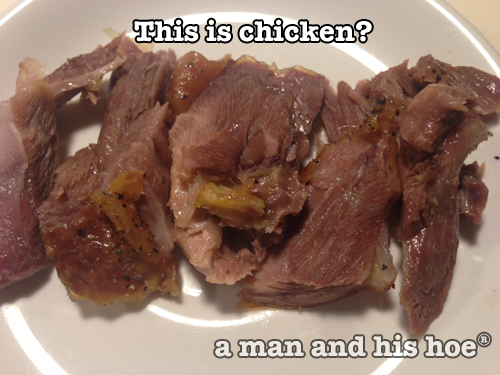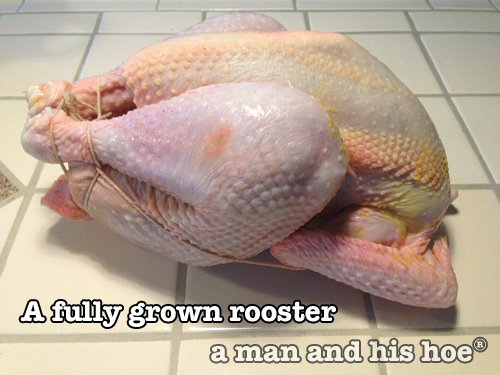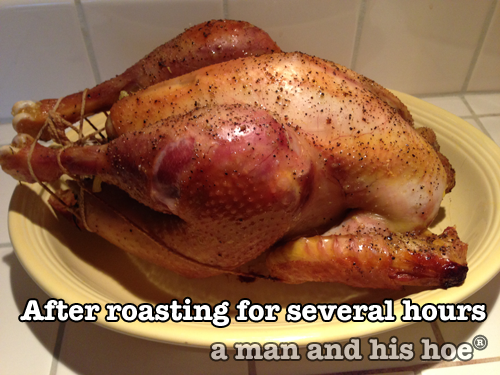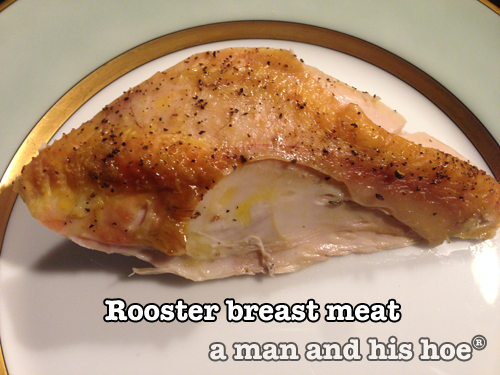Your cart is currently empty!
This Is Chicken?
The variety of meat chicken can provide is truly remarkable. Below is the leg and thigh meat of a roasted, fully grown rooster. The flavor and texture is very similar to a mild goat roast. If you closed your eyes and ate this rich meat, you would have no idea it was chicken.
Gina Bisco in her article Rediscovering Traditional Meats from Historic Chicken Breeds, describes the traditional chicken meat classes, broiler, fryer, roaster and fowl, which were used until the 1940s to describe the various types of chicken meat.

Up until the 1940s, the age at which a chicken was butchered determined its meat class. These classes are no longer used as modern chicken farming has dramatically speeded up the rate at which commercial chickens grow. Most now grow only six to eight weeks before they are processed. They eat voraciously, exercise little, and become fat birds in the blink of an eye. If humans grew at the speed modern chickens do, we would weigh over 300 pounds by the time we were two years old. At that speed, the traditional meat classes become meaningless as there is no difference between a six week old chicken and an eight week old chicken.
Don’t click this link if you are the least bit squeamish, but you get a good idea what modern chicken farming is about in the video: 45 Days: The Life and Death of a Broiler Chicken. Don’t worry, you’ll never find such chicken at A Man and His Hoe. Chickens here are hatched from eggs incubated by loving mothers, and raised with the care only mother hens can provide.

A fully grown rooster is quite impressive when it is trussed and ready to be roasted. Like all chickens which forage for food and walk long distances every day, most of the meat is on the legs and thighs. The redness of the legs and thighs shows through the firm skin.

And roasted, the deep color of the leg and thigh meat is even more evident.
A rooster like this is slow food at its best. Not only do you have to let a rooster grow nearly an entire year, once butchered, you need to let it age in the refrigerator for at least a week before you roast it or pressure cook it, another great way to prepare fully grown rooster.

If you would like to try one of these magnificent birds, call or text me at 360-202-0386, or send an email to theman@amanandhishoe.com. Be advised, that these fully grown roosts are not available all the time, however you are always welcome to get your name on the waiting list for them.

Comments
6 responses to “This Is Chicken?”
-
The suffering of billions of birds is the price of inexpensive chicken. The cruelty of many farmers is hard to fathom. If you eat chicken and/or eggs and are concerned about the treatment of the chickens, there are many farmers who treat their flocks with love and dignity.
-
Are there any standards for using the words “humane” for chicken producers? I searched online for humanely raised poultry in my area and found some providers that claim to be raising chicken humanely, but then describe using heat lamps and slaughtering at 9 weeks? How is that humane? Are you the only one that allows the chickens to raise their own young? By the results of my online search it almost seems so. Very sad there aren’t more humane chicken farms like yours.
-
There is the Certified Humane organization which has developed standards for what they consider to be humane methods for treating animals. You’ll find their blue and green stamp on some produce in the grocery store. I looked into them and anyone can read the various standards they have for various animals on their Our Standards pages. I found their standards for chickens to be rather appalling. For example, in a 10 by 10 foot space, you can have up to 66 chickens. For raising meat birds, you can have up to 6 pounds of chickens per square foot, in other words, you could raise a hundred chickens in a 10 by 10 foot space.
The reason almost no one has mother-raised chickens, is that the modern breeds of chicken which are raised for meat are not capable of raising young. The knowledge to sit on eggs and hatch them has been bred out of them. Getting the roosters to mate with the hens is a challenge too. They don’t know how to stop eating, so the breeding birds need to be kept on starvation diets, otherwise they’d get too fat to mate. Many of them are also breeds that don’t forage. They don’t move around much and pretty much sit around and eat all day. The reason they are butchered so young is that they grow so fast that if they are not slaughtered by 8 to 9 weeks, they start to die because their internal organs can’t keep up with their fast growth. At 9 weeks of age, my chickens are still tiny. It takes them six to nine months to be large enough to eat. Most people want very inexpensive meat, and the way to do that is to have very fast growing chickens that you can cram together. There’s no time for mothering in that world. It’s a system where producers are trying to shave off every penny they can, and having mother hens is out of the question. Love and kindness aren’t factors in the equations used in modern farming. It’s all about inputs and outputs and minimizing costs and maximizing profits. I’m concerned with maximizing happiness, the happiness of the animals I raise and plants I grow.
The chances of finding mother-raised chicken anywhere is very difficult. The end result of raising chickens this way is that you end up with a very different product. It’s more like wild meat than farmed meat, and has to be prepared differently than fast chicken. It’s a very dense, firm meat that works best by letting it age for a week and then roasting or braising at low temperatures for a long time. Most people don’t have time for that. Their lives are too busy.
-
Thank you for the explanation. It is very sad. Perhaps when I retire I can try raising chickens myself, but am not sure I could handle the slaughtering. My grandmother helped cull the chickens her parents raised when she was a child — she said it was hard but was matter of fact about it. However, my suburban backyard, although big by today’s suburban building standards (my home is a community built in the 1950s when the yards were still reasonably sized), might not be large enough to allow for truly happy chickens. Are there any guidelines on how much land chickens need to be happy, or how large a social group they need to be happy? Seems like having fellow chickens to socialize with definitely contributes to their happiness.
-
A flock of four to six hens can live very happily in a large backyard. Most of the guidelines I find are written from the standpoint of how many chickens you can fit in as small a space as possible. They aren’t written by chickens. Heritage breeds like to scratch and dig up earthworms and bugs, so if you’ve got a yard that is 50 by 50 feet or 50 by 100 feet or so, four to six hens will do well. From observing my chickens, I say they like from 500 to 800 square feet per chicken. During the day, they wander, sometimes in groups, sometimes alone. My chickens wander up to about 400 feet away from where they roost at night. They are on the move much of the day but stay within earshot of each other for protection. If they get separated and can’t see another chicken, they will often call to find out where the others are. They like patches of open dirt where they can take dirt baths, especially when it’s sunny. At night they like to roost together for security.
Even four to six hens can do a lot of damage to gardens. They aren’t interested that much in the greens, but in the bugs and earthworms in the soil, so as they scratch and dig for them, they will destroy tender plantings, so garden beds need to be protected from them.
Leave a Reply
You must be logged in to post a comment.